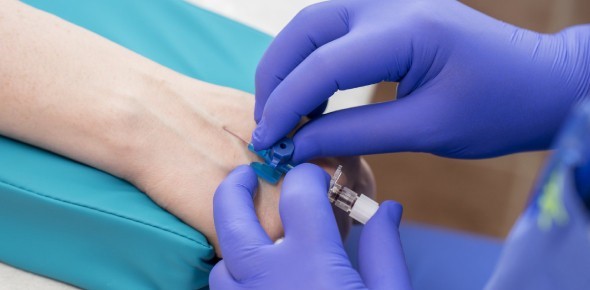A nurse is caring for a client who is receiving mechanical ventilation. Which of the following actions should the nurse implement to decrease the client's risk for ventilator-associated pneumonia (VAP)? (Select all that apply.).
Wear a protective gown when suctioning the client's airway.
Monitor for oral secretions every 2 hr.
Provide oral care every 2 hr.
Maintain the client in a supine position.
Assess the client daily for readiness of extubation.
Correct Answer : B,C,E
Choice A rationale:
While wearing a protective gown is essential to minimize exposure to bodily fluids and to ensure the nurse's protection, it is not specifically aimed at decreasing the risk for ventilator-associated pneumonia (VAP). The key interventions to prevent VAP focus on maintaining airway hygiene and proper positioning, not just personal protective equipment during suctioning.
Choice B rationale:
Monitoring oral secretions every 2 hours is an important strategy in reducing the risk of VAP. Accumulation of secretions in the mouth and upper airway can promote bacterial growth, increasing the risk of aspiration and infection. By regularly assessing and removing secretions, the nurse can reduce the chances of bacteria being aspirated into the lungs and causing pneumonia.
Choice C rationale:
Oral care every 2 hours is a critical intervention to reduce the risk of VAP. Mechanical ventilation predisposes clients to the growth of bacteria in the oral cavity, and poor oral hygiene increases the risk of oral bacteria being aspirated into the lungs. Regular oral care, including brushing teeth, gums, and the tongue, as well as using antiseptic solutions, helps reduce the microbial load in the mouth and decreases the risk of VAP.
Choice D rationale:
Maintaining a client in a supine position is not recommended for preventing VAP. The best practice is to maintain the head of the bed elevated at a 30-45 degree angle (semi-Fowler's position) to reduce the risk of aspiration. A supine position increases the likelihood of gastric contents or secretions being aspirated into the lungs, which can lead to VAP.
Choice E rationale:
Assessing the client daily for readiness for extubation is an essential practice in preventing VAP. The longer a patient remains intubated, the higher the risk of developing VAP due to prolonged exposure of the endotracheal tube in the airway. Regular assessment for extubation helps to ensure that the client is appropriately weaned off the ventilator as soon as they are stable, reducing the risk of VAP and other complications associated with prolonged ventilation.
Nursing Test Bank
Naxlex Comprehensive Predictor Exams
Related Questions
Correct Answer is C
Explanation
Verify that the client has adequate IV access.

Choice A rationale:
Administering vasopressin to the client might be necessary to manage the hemorrhage, but before any medication administration, it is crucial to ensure the client has adequate IV access. Vasopressin is a vasoconstrictor and can help control bleeding from esophageal varices, but its effectiveness relies on IV access to deliver the medication promptly.
Choice B rationale:
Requesting blood from the blood bank is essential for a client experiencing significant bleeding. However, the priority action is to verify IV access to administer any necessary blood products.
Choice C rationale:
This is the correct choice. Before initiating any interventions, ensuring the client has appropriate IV access is a priority. Adequate IV access is necessary to administer fluids, medications, or blood products promptly and effectively stabilize the client's blood pressure.
Choice D rationale:
Inserting an indwelling urinary catheter is not the priority action in this situation. While monitoring urine output is important, it should be secondary to addressing the client's hypotension and hemorrhage.
Correct Answer is A
Explanation
"I changed the floor plan of our home to accommodate my father's wheelchair.”.
Choice A rationale:
This statement indicates acceptance of the role change as a caregiver for the aging parents. Making changes to the home to accommodate the father's wheelchair demonstrates the client's willingness to adapt and provide a suitable environment for caregiving.
Choice B rationale:
Feeling stressed out and overwhelmed does not necessarily indicate acceptance of the role change. It may reflect the challenges and emotional burden that come with caregiving but does not necessarily signify acceptance.
Choice C rationale:
Expressing frustration with caregiving does not necessarily indicate acceptance of the role change. It is normal to feel frustrated at times, especially when dealing with chronic illnesses, but acceptance involves embracing the responsibilities that come with the role.
Choice D rationale:
While the statement shows a willingness to learn and adapt to caregiving, it does not explicitly indicate acceptance of the role change. Acceptance involves acknowledging and embracing the new responsibilities and challenges fully.
Whether you are a student looking to ace your exams or a practicing nurse seeking to enhance your expertise , our nursing education contents will empower you with the confidence and competence to make a difference in the lives of patients and become a respected leader in the healthcare field.
Visit Naxlex, invest in your future and unlock endless possibilities with our unparalleled nursing education contents today
Report Wrong Answer on the Current Question
Do you disagree with the answer? If yes, what is your expected answer? Explain.
Kindly be descriptive with the issue you are facing.
